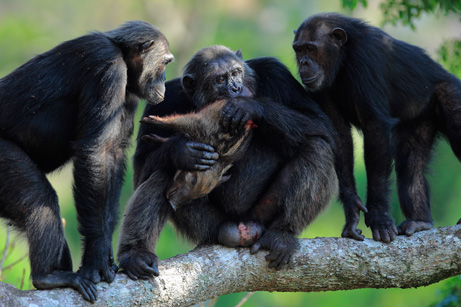A hunter claims that he watched a wood ape hunt, slay and carry off a wild hog weighing roughly 100 to 125 pounds.
A farmer claims that he watched a wood ape pick up and attempt to carry off one of his domestic hogs, a 400-pound boar, before he fired at the creature, causing it to drop the hog.
Wood apes that carry off calves. Wood apes robbing chicken pens. Are such claims outrageous? At first glance, perhaps so.
However, when one considers that such behavior has parallels among the known non-human great apes, such activity no longer seems so outlandish.
Chimpanzees, for example, are known to be omnivores. They eat meat, sometimes hunting and eating monkeys and other small animals.
Now there is photographic evidence that chimps also hunt, slay and eat wild pigs.
What is particularly interesting is that reports of wood apes hunting, killing, and/or carrying off hogs, calves, deer, goats and other large animals, all originated well before chimpanzees were known to engage in comparable behaviors. For example, an 1851 Arkansas newspaper account described “a wild man of the woods” seen “pursuing a herd of cattle, who were flying in a state of great alarm, as if pursued by a dreaded enemy.”
The “animal bearing the unmistakable likeness of humanity” ran away from his observers “with great speed, leaping from twelve to fourteen feet at a time.” The footprints measured thirteen inches each; the wild man was “of gigantic structure, the body being covered with hair.” The “singular creature” pursuing the cattle clearly met the description of a wood ape.
A fully-grown male chimpanzee usually ranges in size from 120 to 140 pounds, and averages between four and five feet in height. The average reported height for wood apes in the TBRC data base is roughly seven feet in height. Given the muscle density of the known great apes, it seems reasonable to propose that a seven-foot wood ape might easily carry a 200-pound hog or two, especially if chimpanzees can hunt, kill, carry and eat wild pigs.
Other wood ape behavioral characteristics have been reported well before similar behaviors were documented among non-human great apes. In general, such correlations can be seen as lending credence to this form of anecdotal evidence.
Source: National Geographic News.
Other interesting links: Nature.com; Smithsonian.com.

